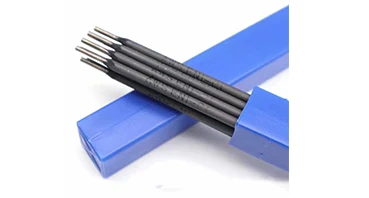AWS EZ308 Cast Iron Welding Rods 2.0mm-5.0mm
Fev . 18, 2025 01:37
Cast iron, renowned for its durability and excellent heat retention properties, often features prominently in manufacturing and restoration projects. However, repairing cast iron components can be challenging due to its brittle nature, particularly when it comes to welding. Enter the cast iron welding rod—a specialized tool crucial for achieving strong, reliable repairs or fabrications. Knowing how to select and use this product effectively can substantially influence the success of a project. Here’s an in-depth look at the utilization of cast iron welding rods.
The success of using a cast iron welding rod is not just in the choice of rod but also in the methodology applied. Maintaining a slow and steady approach is crucial. Cast iron is notorious for its tendency to crack due to rapid cooling. Preheating the component before welding and allowing it to cool down slowly afterwards can significantly reduce the thermal stresses that lead to cracking. Selecting a welding rod with compatible thermal properties also aids in reducing this risk. Another vital aspect lies in the expertise of the welder. An experienced welder understands the need for controlling the heat input and recognizes the subtleties of bead placement. Short, stringer beads often work best for cast iron since they minimize heat buildup, thus reducing the risk of cracks. Additionally, the use of a back-and-forth oscillating motion can help control the bead profile to better accommodate the stiff nature of cast iron. Successful welding of cast iron also depends on the trustworthiness of the materials used. It's essential to source welding rods from reputable manufacturers who provide consistent quality and performance metrics. Investing in higher quality rods often results in longer-lasting repairs and fewer issues in post-weld inspections and usage. When discussing the reliability of cast iron welding rods, one cannot overlook the importance of peer experiences and testimonials. Networking with industry professionals, participating in forums, or engaging with online communities dedicated to welding can offer invaluable insights and recommendations that augment one’s personal expertise. In summary, choosing the right cast iron welding rod and employing a precise welding technique are pivotal for achieving optimal repair outcomes. Adapting the approach based on the specific requirements of the task, such as the type of component and its intended use, ensures that repairs not only hold up under scrutiny but also extend the longevity of the cast iron components. Through a combination of product knowledge, skillful technique, and quality materials, the challenging nature of working with cast iron can be successfully navigated.


The success of using a cast iron welding rod is not just in the choice of rod but also in the methodology applied. Maintaining a slow and steady approach is crucial. Cast iron is notorious for its tendency to crack due to rapid cooling. Preheating the component before welding and allowing it to cool down slowly afterwards can significantly reduce the thermal stresses that lead to cracking. Selecting a welding rod with compatible thermal properties also aids in reducing this risk. Another vital aspect lies in the expertise of the welder. An experienced welder understands the need for controlling the heat input and recognizes the subtleties of bead placement. Short, stringer beads often work best for cast iron since they minimize heat buildup, thus reducing the risk of cracks. Additionally, the use of a back-and-forth oscillating motion can help control the bead profile to better accommodate the stiff nature of cast iron. Successful welding of cast iron also depends on the trustworthiness of the materials used. It's essential to source welding rods from reputable manufacturers who provide consistent quality and performance metrics. Investing in higher quality rods often results in longer-lasting repairs and fewer issues in post-weld inspections and usage. When discussing the reliability of cast iron welding rods, one cannot overlook the importance of peer experiences and testimonials. Networking with industry professionals, participating in forums, or engaging with online communities dedicated to welding can offer invaluable insights and recommendations that augment one’s personal expertise. In summary, choosing the right cast iron welding rod and employing a precise welding technique are pivotal for achieving optimal repair outcomes. Adapting the approach based on the specific requirements of the task, such as the type of component and its intended use, ensures that repairs not only hold up under scrutiny but also extend the longevity of the cast iron components. Through a combination of product knowledge, skillful technique, and quality materials, the challenging nature of working with cast iron can be successfully navigated.
Related Video
Copyright © 2025 Dingzhou Jinlong Metal Production Co., Ltd. All Rights Reserved. Sitemap | Privacy Policy




























